PERSIMMONS
Diospyros kaki
Astringent or Non-Astringent?
The most widely cultivated species of persimmons are the Japanese persimmons, and come in 2 classes: astringent or non-astringent. Some call it "puckering" or "non-puckering".
Non-astringent persimmons can be eaten fresh right from the tree and are crisp like an apple.
Astringent persimmons are best picked and ripened for a few days until soft and nearly mushy before they are sweet enough to eat.
They are the sweetest: richer and juicier than the non-astringents.
Astringents are sweet like maple syrup when ripe, and quite interesting as a dried delicacy. Non-astringents are a more mellow sweet like cantaloupe or sugarcane.
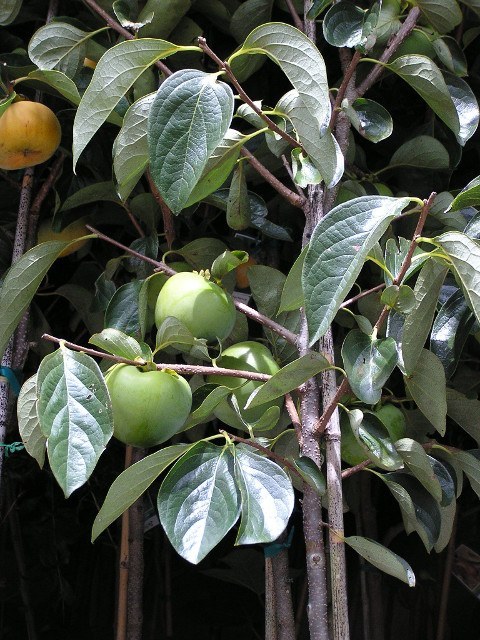
Fuyu persimmons in August on a 7G tree.
Choosing Your Location for planting:
Research at Stellenbosch Univ (South Africa) showed that
Persimmons are sensitive to too much wind. Strong winds stress the fruit, causing them to produce excess ethylene which usually leads to premature ripening and a shorter shelf life.
Non-Astringent persimmons include 4 kinds
of FUYUs and
3 kinds of JIROs:
Non-astringent persimmons can be eaten fresh right from the tree and are crisp like an apple.
FUYU
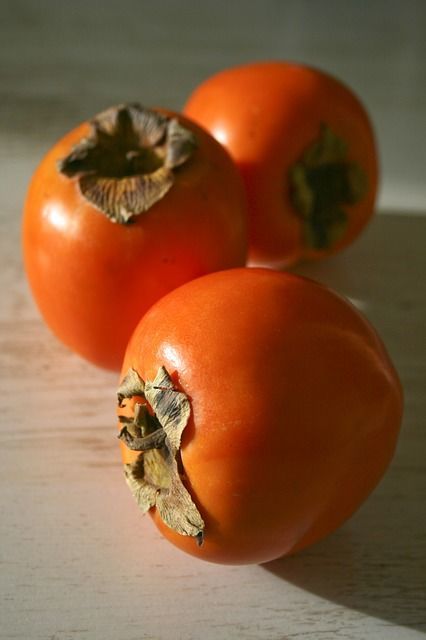
The original FUYU is the most popular of all the oriental persimmons. Hardy / vigorous growing tree, up to 15' hgt.
Consistent producer of med. sized fruit: 4.5-6 oz. Fruit is crisp, sweet and mild; many layers of flavor: reminiscent of pear, dates and brown sugar, with nuances of cinnamon.
Ripens early Oct thru Nov: best choice for wildlife (deer) food plots.
Zones 7-9; 10a
MATSUMODA-WASE FUYU

Matsumoda persimmons on the tree
Matsumoda-Wase FUYU is so close in flavor to the original FUYU it is difficult to distinguish the difference.
Vigorous growing trees, a little larger than the original FUYU, up to 16-18' tall. Consistent heavy bearer.
Ripens 2 wks earlier: about mid-Sept
Zones 7-9; 10a
GIANT FUYU

Giant Fuyu in a collander
Giant FUYU is a much smaller tree, reaching only about 12' at maturity. Very vigorous growing tree.
Very large reddish-orange fruit.
Ripens late Sept & Oct.
Zones 7-9
HANA FUYU
(picture to follow)
Hana FUYU is more of dwarf persimmon tree at only 10'.
Fruit is large, reddish-orange, somewhat squarish (i.e. appears to have 4-lobes), and is slightly flattened.
Very sweet and crispy.
Ripens mid-October.
Zones 6-9
JIRO
(picture to follow)
JIRO is one of the most cold-hardy of the non-astringent persimmons.
Fruit is large, has 4-lobes and is slightly flattened on the bottom, much like the Hana Fuyu. Turns a beautiful orange red color when ripe.
Ripens mid-Oct to mid-Nov.
Zones 6-8b, maybe 9a
MAEKAWA JIRO
(picture to follow)
Maekawa-JIRO is one of the best tasting persimmons.
Semi-dwarf at 10-12' max. hgt.
Fruit is large, 4-lobed, and slightly flattened much like the other Jiro types.
Ripens mid-Oct to mid-Nov.
Zones 7-8b, maybe 9a
ICHI-KI-KEI-JIRO
(picture to follow)
Ichi-Ki-Kei-Jiro is another semi-dwarf at 10-12' tall, but the tree is a little more cold tolerant than the Maekawa.
Fruit is large, 4-lobed and slightly flattened just like the other Jiro types.
Ripens mid to late Oct.
Zones 6-8b, maybe 9a
Astringent persimmons include:
Astringent persimmons can be as sweet as maple syrup if picked and allowed to ripen fully before eating.
They must be entirely soft and nearly mushy to be ripe and sweet, and are therefore too fragile for shipping.
TANENASHI
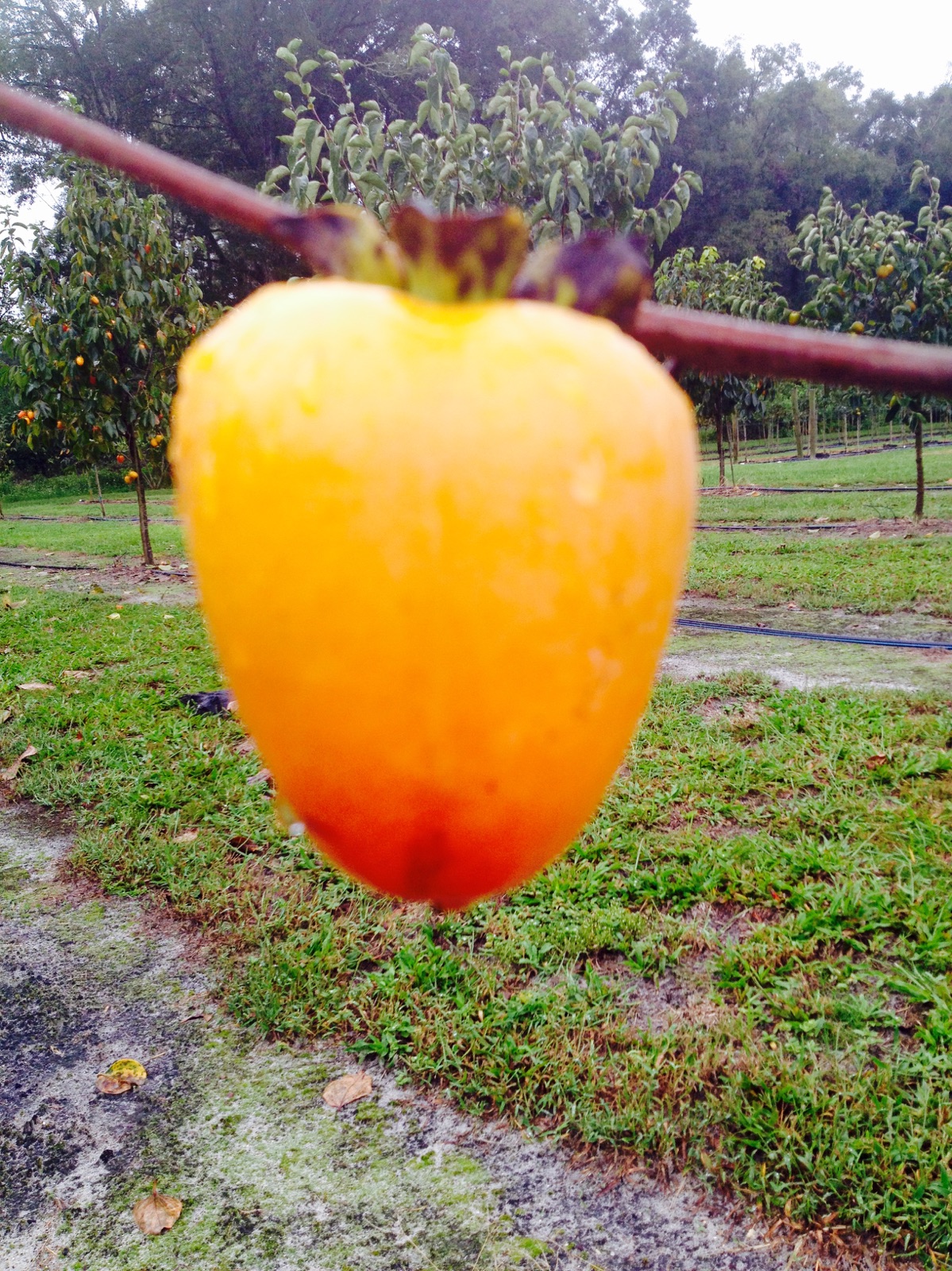
Tanenashi is the most highly recognized name among astringent persimmons. The name 'Tanenashi' means seedless.
Vigorous growing trees to 12-15' tall, consistently produces good crops.
Fruit is med-large, cone-shaped, and orange-red. Flesh is yellow when ripe with a dry texture.
Ripens early Oct into Nov.
Zones 7-9
HACHIYA

Hachiya is one of the best for flavor and quality: possibly the most popular astringent.
Large, deep red fruit weighing a pound or more, has a jelly-like consistency, and a sweet and spicy flavor.
Ripens mid Oct to late Nov.
Zones 7-9.
SAIJO
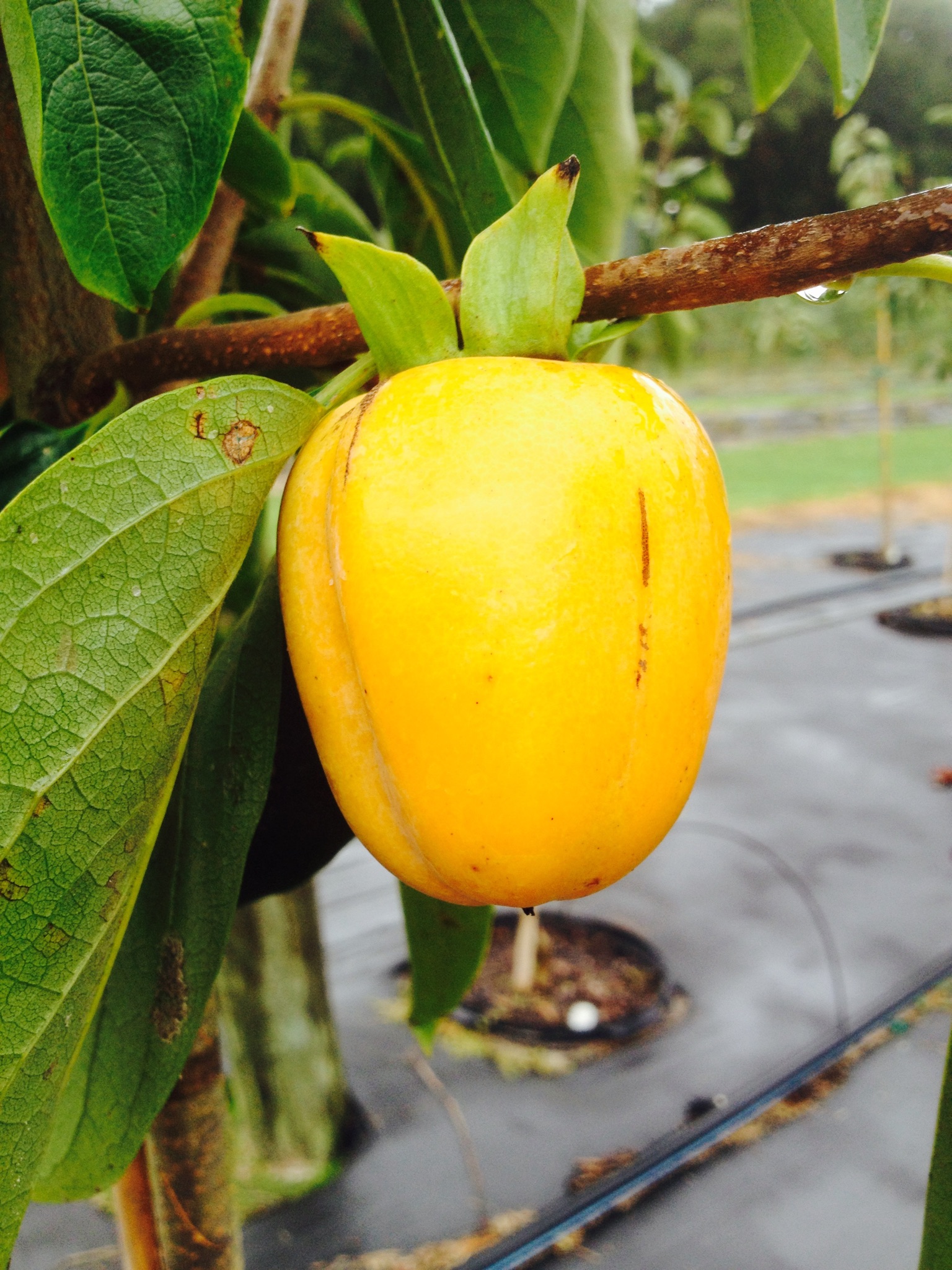
Saijo fruits are quite oblong: 1.5-2" long x 1" in diameter, orange when ripe and very sweet. The name 'Saijo' means 'the very best one' in Japanese.
Fruit flavor when ripe is reminiscent of a combo of mango, peach, apricot and banana, dripping in brown sugar.
Trees are vigorous, upright growers, up to 20-25' tall.
Ripens mid-Sept. to mid-Oct.
Zones 7-9.
GIOMBO

Giombo fruit is large, about the same size as Hachiya but is very sweet much like the Saijo. Trees grow to 15'+.
Giombo is a biennial bearer when young.
Ripens mid-Oct through Nov., at least 2 wks after Saijo.
Zones 7-9
GREAT WALL
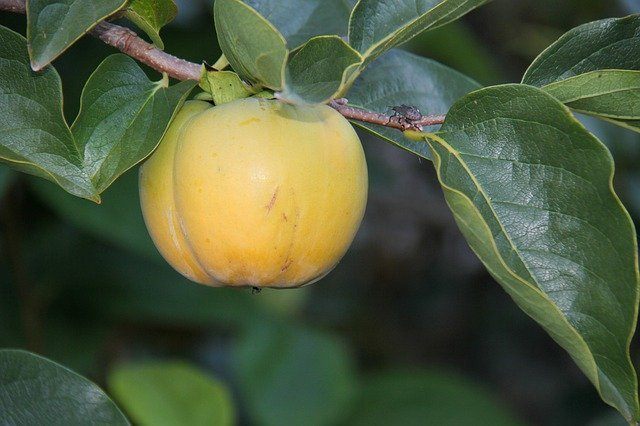
(unripe) Great Wall fruit
Great Wall fruit is more of a tomato shape, and sunset orange with thick, rich flavor.
Excellent quality fruits similar to Tanenashi, vigorous growing in FL, biennial bearing (meaning every other year).
Fruit ripens late Sept through October.
Zones 6-9
CHOCOLATE
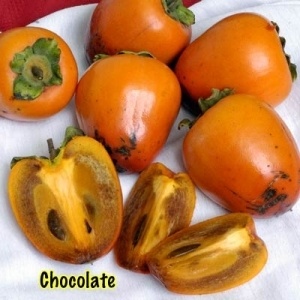
Chocolate has small to medium sized oblong fruit with bright red skin.
Unique, spicy brown flesh is sweet with superb flavor. Brown streaked flesh when pollinated, more orange if not pollinated and non-astringent.
Tree grows to 12-15' tall.
Ripens late Oct through Nov.
Zones 6-9
NIKITA'S GIFT
Diospyrus virginiana x kaki
(picture to follow)
Nikita's Gift is a Russian (Ukranian) hybrid of American and Asian persimmons. Fruit is a little flat on the bottom, 2-3" across, dark reddish-orange in color, and exceptionally sweet when ripe.
Mature tree hgt is about 12'
very cold hardy;
Ripens late Oct through Nov. More cold hardy than some: Zones 6-9
. . . and coming Fall 2020 / Spring 2021:
ORMOND aka
'CHRISTMAS' variety
photo coming soon
Ormond is a 2.5" long fruit about 2" in diameter; fruits are reddish-yellow outside and deep orange-red inside, very sweet, moderately juicy, with large seeds. Fruits hang in clusters like grapes.
Vigorous mid-sized tree suited to warmer climates; breaks bud early in the spring, increasing chances for freeze injury in the northern parts of its growing zones.
Ripens very late: Nov and Dec in FL, maybe Jan.
Zones 8-9 only
TRIUMPH
photo coming soon
Triumph is widely grown in Israel, known there as "Sharon fruit". Unlike most other persimmons, Triumph doesn't need any chill hours below 45 degrees to bloom and fruit, and so it is thriving even in Homestead, FL!
Small, squarish fruit is extremely juicy with few or even no seeds. Though it is an astringent variety, it has a firm skin even when ripe, making it a good candidate for shipping.
Research at the Univ of Bonn (1984) shows very high levels of carotenoids in the skin of 'Triumph', including an increase of lycopene in the last stages of ripening.
Lengthy harvest time:
Fruit ripens Sept to Nov in FL
ripens Apr-June in S. Africa
Zones 9-10a
WINTER SET
Fruit ripens late Nov / Dec
Zones 9-10a
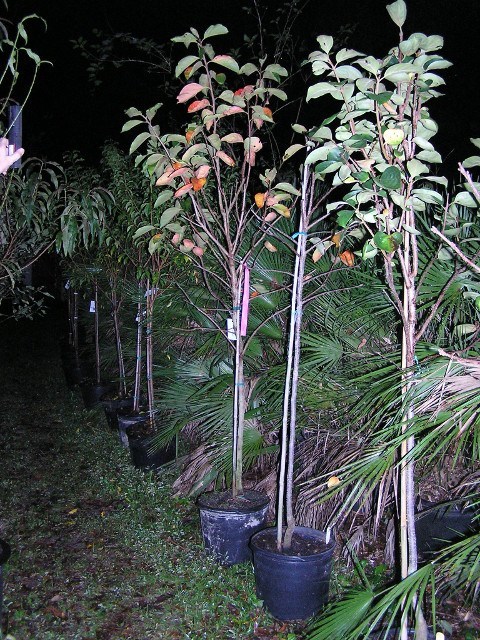
Early Fall colors on Persimmon Trees
Persimmon leaves will turn an array of gorgeous colors in the fall -- yellows, oranges and even some bright reds -- before dropping for winter.
Often the leaves will begin turning colors while the fruit is still on the tree. Trees will appear dormant for winter months.
If planted in cooler areas of the state, give full sun and wind protection. If planted in zone 9b or 10a, the original Fuyu or the Matsumoda Fuyu will be hardier and more vigorous, as non-astringent varieties. For astringents, consider the Saijo (to zone 9b) as well as the Ormond or Christmas persimmon, especially if in zones 10a or 10b.
